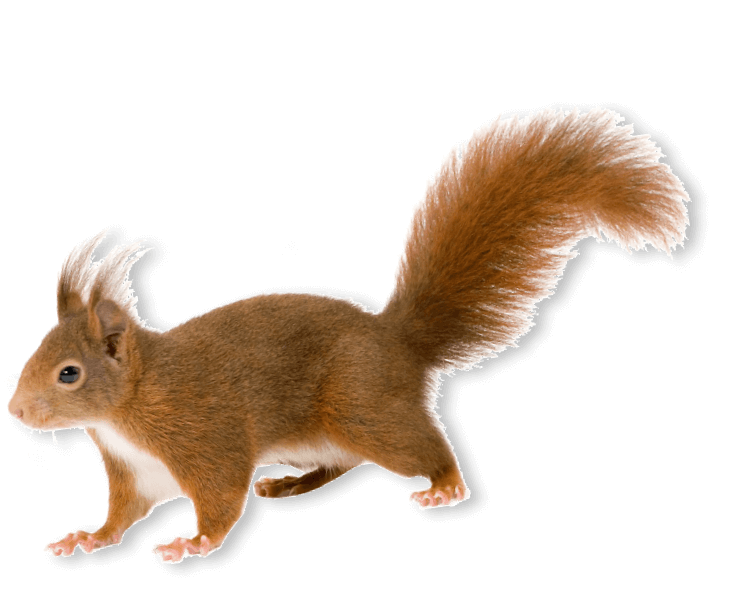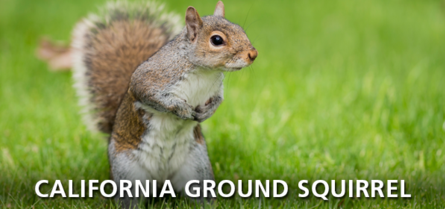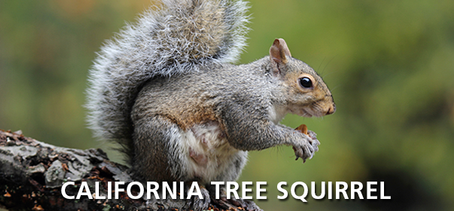
Squirrel Identification
Call Now 800-901-1102

What’s a Squirrel?

CALIFORNIA GROUND SQUIRRELS:
Ground Squirrels are diurnal animals (active during the day and sleep during the night) and in Southern California, are active year around. Ground Squirrels live in family groups often sharing burrow systems. It is easy to identify ground squirrels, since they forage above ground near their burrows. Their home range typically is within a 75-yard radius of their burrow.
Their body measures 9 to 11 inches, while their semi-bushy tail adds another 5 to 9 inches in length. Their fur is brownish gray and speckled with off white along the back; the sides of the head and shoulders are light gray to whitish. One subspecies (the Douglas ground squirrel) that inhabits most of Northern California has a dark, triangular-shaped patch on its back between the shoulders; this patch is missing from other species.
Ground squirrels breed once a year, averaging 7 to 8 per litter. Timing of breeding varies with location. In Southern California breeding begins in December, in the Central Valley the timeframe is February through April, and in the mountain ranges breeding begins somewhat later. Aboveground activity by adults is at a maximum at the height of the breeding season. The young are born in the burrow and grow rapidly. When they are about 6 weeks old, they usually emerge from the burrow. At 6 months they well on their way to adulthood.
Ground squirrels are primarily herbivorous, and their diet changes with the season. In late winter and early spring, they feed almost exclusively on green grasses and herbaceous plants. When annual plants begin to dry and produce seed, squirrels switch to seeds, grains, fruits and nuts and begin to store food.
Although ground squirrels look similar to tree squirrels and can climb trees, when frightened they will always retreat to a burrow, whereas tree squirrels will climb a tree or tall structure and never use a burrow.
Be aware that several of the numerous ground squirrel species are on the threatened or endangered species lists. Any control of pest species must take into consideration the safeguarding and protection of endangered ground squirrels and other rodent species.

CALIFORNIA TREE SQUIRRELS:
There are four species of tree squirrels in California, excluding the small nocturnal flying squirrel, which is not considered a pest. Of the four, two species are native including the California Grey and two are introduced from the eastern part of the United States. In their natural habitats they eat a variety of foods including fungi, insects, bird eggs and young birds, pine nuts, and acorns, plus a wide range of other seeds.
They also have a habit, mostly in the fall, of digging holes in garden soil or in turf, where they bury nuts, acorns, or other seeds. This caching of food, which they may or may not ever retrieve, raises havoc in the garden and tears up a well-groomed lawn. They sometimes gnaw on telephone cables and may chew their way into wooden buildings or invade attics through gaps or broken vent screens.
In General
Squirrels are frequently infested with fleas, mites, ticks and other ectoparasites. In addition, there is the possibility of their spreading plague to humans. The bubonic plague, caused by the bacterium Yersinia pestis, is common in ground squirrels, particularly in the Southwest. Plague spreads to humans through bites from the squirrel or from fleas that have fed on the squirrel. Squirrels can spread a variety of additional diseases. Tularemia, caused by the bacterium Francisella tularensis, spreads through bites from infected animals, skin contact with sick or dead squirrels, ingestion of contaminated water or tick and deer fly bites from insects feeding on infected squirrels. Leptospirosis is another common disease spread by squirrels. Leptospirosis can lead to kidney and liver failure though infected squirrels may show no symptoms. To avoid contracting a disease from squirrels, do not attempt to feed or handle squirrels, especially if they appear ill. Use insect repellant sprays in areas where flea or tick bites may occur.
 800-901-1102
800-901-1102